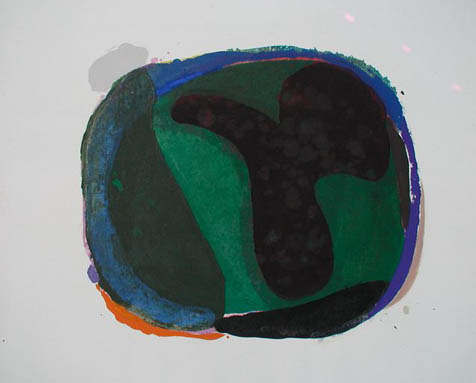The Rediscovery of Selden Spaulding.
At Patty Look Lewis Gallery. Shows through September 29.

Selden “Denny” Spaulding’s work of the 1960s ought to spark a widespread revival of interest in one of Santa Barbara’s most original abstract artists. Spaulding was educated at Laguna Blanca School where his father, Edward Selden Spaulding, was the first headmaster, and at Princeton, where he majored in art and archaeology. After serving in World War II, Spaulding relocated to the French countryside in 1950.
By the early 1960s, he had discovered a technique of drip painting that put him in between the “action painting” of Jackson Pollock and the delicate, multilayered luminosity of late-period Monet. The canvases on show this month at Patty Look Lewis Gallery fall into three groups: “dark-period” abstractions that revel in the viscosity of brown and black oil paints and waxes; middle-period canvases based on a single color that have an all-over surface and were produced using the drip method; and later abstractions emphasizing the liminal effects of layered, loosely geometric forms.
Once seen in any quantity, Spaulding’s abstract work is instantly recognizable. The surfaces and shifting figure/ground relations of the middle-period paintings suggest the evanescence and multiplicity of sunlight on water, an effect the artist achieved by carefully dropping thousands of tiny paint globs onto linen from a height of 30 feet while working inside an old French barn. In such paintings as “Red,” from 1963, stacked bands of subliminal color create the physical sensation of pictorial space without requiring a visible horizon line.
At once radical and sincere, bold and sensitive, Spaulding’s work radiates a single-minded devotion to the highest aesthetic and social ideals of the 1950s and ’60s. Upon returning to Santa Barbara in 1969, Spaulding staged a memorable one-man show at the Santa Barbara Museum of Art in which he wrapped two entire galleries in canvas so that he could paint an all-encompassing environment-an early and remarkable instance of avant-garde art activity on State Street.
His paintings of the later 1960s are characterized by halo effects-places where colors bleed free at the edges of larger shapes. Spaulding, who died in 2005, spoke frequently of his desire to indicate in his art the fleeting nature of emotional experience, and the lovely, fluttering lines at the edges of these works are likely traces of that impulse. They reveal the powerful emotions of a singular life as auroras of pure color and light glimmering around the central shadows of an outstanding imagination.



